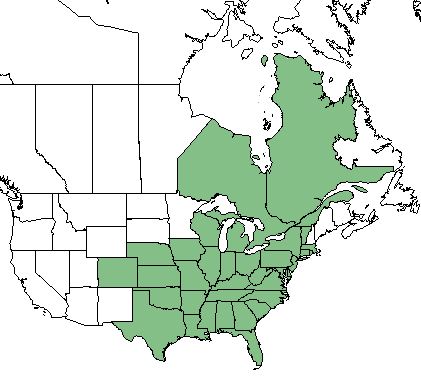Difference between revisions of "Ludwigia alternifolia"
Emmazeitler (talk | contribs) (→Taxonomic Notes) |
Emmazeitler (talk | contribs) |
||
| Line 1: | Line 1: | ||
{{italic title}} | {{italic title}} | ||
| − | Common name: seedbox <ref name= "USDA Plant Database"/>, alternate-leaf seedbox <ref name= "Weakley 2015"/> | + | Common name: seedbox<ref name= "USDA Plant Database"/>, alternate-leaf seedbox<ref name= "Weakley 2015"/> |
<!-- Get the taxonomy information from the NRCS Plants database --> | <!-- Get the taxonomy information from the NRCS Plants database --> | ||
{{taxobox | {{taxobox | ||
| Line 25: | Line 25: | ||
==Description== | ==Description== | ||
<!-- Basic life history facts such as annual/perrenial, monoecious/dioecious, root morphology, seed type, etc. --> | <!-- Basic life history facts such as annual/perrenial, monoecious/dioecious, root morphology, seed type, etc. --> | ||
| − | ''L. alternifolia'' is a perennial forb/herb of the ''Onagraceae'' family native to North America and Canada. <ref name= "USDA Plant Database"> USDA Plant Database [https://plants.usda.gov/core/profile?symbol=LUAL2 https://plants.usda.gov/core/profile?symbol=LUAL2] </ref> | + | ''L. alternifolia'' is a perennial forb/herb of the ''Onagraceae'' family native to North America and Canada.<ref name= "USDA Plant Database"> USDA Plant Database [https://plants.usda.gov/core/profile?symbol=LUAL2 https://plants.usda.gov/core/profile?symbol=LUAL2] </ref> |
==Distribution== | ==Distribution== | ||
| − | ''L. alternifolia'' | + | ''L. alternifolia'' ranges from Massachusetts to north Florida and east Texas, and west to southern Ontario, southern Michigan, Iowa, and Kansas.<ref name="weakley">Weakley, A.S. 2015. Flora of the southern and mid-atlantic states. Working Draft of 21 May 2015. University of North Carolina at Chapel Hill, Chapel Hill, North Carolina.</ref> |
==Ecology== | ==Ecology== | ||
===Habitat=== <!--Natural communities, human disturbed habitats, topography, hydrology, soils, light, fire regime requirements for removal of competition, etc.--> | ===Habitat=== <!--Natural communities, human disturbed habitats, topography, hydrology, soils, light, fire regime requirements for removal of competition, etc.--> | ||
| − | ''L. alternifolia'' is found in freshwater tidal marshes, ditches, other marshes, open wet places, and disturbed wet places. <ref name= "Weakley 2015"> Weakley, A. S. (2015). Flora of the Southern and Mid-Atlantic States. Chapel Hill, NC, University of North Carolina Herbarium. </ref> Specimens have been collected from wooded | + | ''L. alternifolia'' is found in freshwater tidal marshes, ditches, other marshes, open wet places, and disturbed wet places.<ref name= "Weakley 2015"> Weakley, A. S. (2015). Flora of the Southern and Mid-Atlantic States. Chapel Hill, NC, University of North Carolina Herbarium. </ref> Specimens have been collected from wooded floodplains, mesic woodlands, moist loamy sands, depression of wiregrass longleaf woodland, open grassy meadow, swamps edges, mesic cypress dome verge, exposed lake bed and other disturbed drainage areas such as ditches on roadside.<ref name = "FSU herbarium"> URL: http://herbarium.bio.fsu.edu. Last accessed: June 2018. Collectors: Loran C. Anderson, kathy Craddock Burks, Gary Knight, R.K. Godfrey, Neal Morar, R. Kral, T. MacClendon, karen MacClendon, R.F. Doren, R. Komarek, J.M. Kane, John Nelson, Leah Garris, Frank Lee, Keith Bradley. States and counties: Florida (Franklin, Bay, Leon, Okaloosa, Gulf, washington, Gadsden, Liberty, Santa Rosa, Jackson, Walton, Calhoun, Holmes) South Carolina (Kershaw, Richland) Georgia (Thomas) Texas (Orange)</ref> |
===Phenology=== <!--Timing off flowering, fruiting, seed dispersal, and environmental triggers. Cite PanFlora website if appropriate: http://www.gilnelson.com/PanFlora/ --> | ===Phenology=== <!--Timing off flowering, fruiting, seed dispersal, and environmental triggers. Cite PanFlora website if appropriate: http://www.gilnelson.com/PanFlora/ --> | ||
| − | ''L. alternifolia'' | + | ''L. alternifolia'' flowers from June through October.<ref name= "PanFlora"> Nelson, G. PanFlora: Plant data for the eastern United States with emphasis on the Southeastern Coastal Plains, Florida, and the Florida Panhandle. www.gilnelson.com/PanFlora/ Accessed: 24 MAY 2018 </ref> |
<!--===Seed dispersal===--> | <!--===Seed dispersal===--> | ||
<!--===Seed bank and germination===--> | <!--===Seed bank and germination===--> | ||
Revision as of 16:21, 24 September 2020
Common name: seedbox[1], alternate-leaf seedbox[2]
| Ludwigia alternifolia | |
|---|---|

| |
| Photo by the Illinois Wildflowers Database | |
| Scientific classification | |
| Kingdom: | Plantae |
| Division: | Magnoliophyta - Flowering plants |
| Class: | Magnoliopsida - Dicots |
| Order: | Myrtales |
| Family: | Onagraceae |
| Genus: | Ludwigia |
| Species: | L. alternifolia |
| Binomial name | |
| Ludwigia alternifolia L. | |

| |
| Natural range of Ludwigia alternifolia from USDA NRCS Plants Database. | |
Contents
Taxonomic Notes
Synonyms: none.[3]
Varieties: none.[3]
Description
L. alternifolia is a perennial forb/herb of the Onagraceae family native to North America and Canada.[1]
Distribution
L. alternifolia ranges from Massachusetts to north Florida and east Texas, and west to southern Ontario, southern Michigan, Iowa, and Kansas.[3]
Ecology
Habitat
L. alternifolia is found in freshwater tidal marshes, ditches, other marshes, open wet places, and disturbed wet places.[2] Specimens have been collected from wooded floodplains, mesic woodlands, moist loamy sands, depression of wiregrass longleaf woodland, open grassy meadow, swamps edges, mesic cypress dome verge, exposed lake bed and other disturbed drainage areas such as ditches on roadside.[4]
Phenology
L. alternifolia flowers from June through October.[5]
Conservation and Management
Cultivation and restoration
Photo Gallery
References and notes
- ↑ 1.0 1.1 USDA Plant Database https://plants.usda.gov/core/profile?symbol=LUAL2
- ↑ 2.0 2.1 Weakley, A. S. (2015). Flora of the Southern and Mid-Atlantic States. Chapel Hill, NC, University of North Carolina Herbarium.
- ↑ 3.0 3.1 3.2 Weakley, A.S. 2015. Flora of the southern and mid-atlantic states. Working Draft of 21 May 2015. University of North Carolina at Chapel Hill, Chapel Hill, North Carolina.
- ↑ URL: http://herbarium.bio.fsu.edu. Last accessed: June 2018. Collectors: Loran C. Anderson, kathy Craddock Burks, Gary Knight, R.K. Godfrey, Neal Morar, R. Kral, T. MacClendon, karen MacClendon, R.F. Doren, R. Komarek, J.M. Kane, John Nelson, Leah Garris, Frank Lee, Keith Bradley. States and counties: Florida (Franklin, Bay, Leon, Okaloosa, Gulf, washington, Gadsden, Liberty, Santa Rosa, Jackson, Walton, Calhoun, Holmes) South Carolina (Kershaw, Richland) Georgia (Thomas) Texas (Orange)
- ↑ Nelson, G. PanFlora: Plant data for the eastern United States with emphasis on the Southeastern Coastal Plains, Florida, and the Florida Panhandle. www.gilnelson.com/PanFlora/ Accessed: 24 MAY 2018